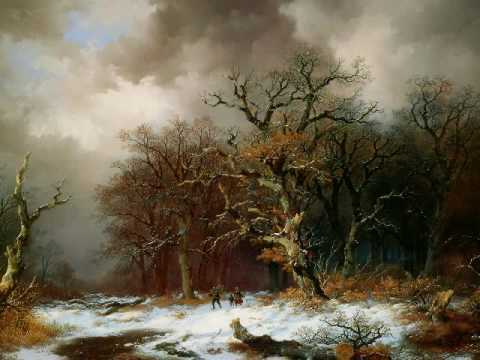Section I
depicts the wind in its dual aspect of being a destroyer and a preserver. It opens with the customary address to the West Wind which blows heavily in autumn season. But here, autumn is not mellow and fruitful as in Keats’ Ode to Autumn. The poet calls the West Wind the breath or the soul of autumn. It is a wild spirit invisible like a ghost; the leaves are dead and fallen from the trees and are compared to ghosts that fly in the magical spell of an enchanter. Thus, the west wind is completely presented as a destroyer.
The speaker uses different colors such as yellow, black, pale and wild red which constitute the autumn season as a season of fall and death. Death and life, however, are simultaneously discussed. The seeds scattered by the West Wind are only seemingly dead in the winter and then it sprouts everywhere with the arrival of the soft and warmth spring season. In fact the spring season can refill the earth with hues and odours of life in everyplace including high and low.
Once again speaker addresses the powerful wind and says that it can move everywhere and can ruin as well as restore.

Section II
The setting shifts from the land to the sky. The sky’s clouds are “like Earth’s decaying leaves”. They are “shook from the tangled boughs of Heaven and Ocean”. In the sky it forms the future rain storms and clouds.
The force of West Wind causing commotion (noisy movement) in the sky is depicted with the help of three images. First is the image of the sky filled with storm-clouds which the wind shakes as it shakes the trees on earth. The second image describes the sky as a Maenad (dancing girl of Dionysus) whose hair shakes in the wind (moving clouds as the result of wind is personified here). The third image is connected with death and the tomb. What is dying is the old year (season), symbolically, the old forms; the sky is now becomes completely dark and foggy. like a vault (roof) of a black tomb, in which the season will be buried. The wind is both dirge of the dying year, and a prophet of regeneration.
Section III
This section presents a picture of the calm Mediterranean Sea and it appears dazzling blue and crystal clear as it is in summer and early autumn. Old Italian villas, moss-grown palaces, ruined castles with gardens full of bright flowers line the shores and the calm sea reflects all this beauty on its glassy surface. Then the passage of the west wind creates powerful waves above the ocean. The flowers and weeds in the deep below the sea became sapless (dry) and grey by hearing the voice of the wind. Its shakes and destroys their flowers and leaves.
Section IV
The speaker dramatically expresses certain situation; for instance, his longing to be as 'leaf, ‘cloud’ and 'wave'. We have, here, implications of romantic melancholy. He prays to the West Wind to lift him out of the age of ties, responsibilities and claims in a suffering society. A strong personal note is evident in this stanza.
Section V
The concluding lines are magnificent expression of hope and delight.
“Tameless, swift and proud: Shelley's spirit is like the spirit of the West
Wind, he cannot despair. The Wild West Wind inspires Shelley to write poetry
and this poetry, in turn, serves as an inspiring message to humanity. This
message would fire human hearts, kindling the desire for progress and a better
world. Thus, the poem closes on a note of ardent hope. O Wind, “If Winter
comes, can Spring be far behind?”.

No comments:
Post a Comment
looking forward your feedbacks in the comment box.